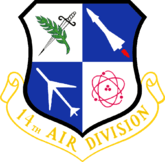14th Air Division
14th Air Division
 | |
|---|---|
| Active | 1940–1942; 1942–1945; 1951–1991 |
| Country |
|
| Branch |
|
| Engagements | European Theater of Operations |
| Insignia | |
| 14th Air Division emblem (approved 16 November 1962)[1] |
 |
The 14th Air Division is an inactive United States Air Force unit. Its last assignment was with Fifteenth Air Force, stationed at Beale Air Force Base, California. It was inactivated on 14 June 1989.
History
World War II
The organization was initially activated in Hawaii as the 14th Pursuit Wing to contribute to the defense of the Hawaiian Islands. Its designation was soon changed to Hawaiian Interceptor Command. The Hawaiian Interceptor Command suffered heavy losses during the Japanese attack on Pearl Harbor (7 December 1941), but airmen managed to shoot down several enemy aircraft.[1] A short time later, it was inactivated and its men and equipment became the cadre for VII Fighter Command.
The wing was reformed as the 14th Bombardment Wing, the unit was one of the primary Consolidated B-24 Liberator heavy strategic bombardment groups of the Eighth Air Force's 2d Bombardment Division in World War II. Its subordinate groups flew bombing missions against German airfields, oil installations, and marshalling yards. Wing components supported Operation Overlord, the invasion of Normandy, in June 1944 by attacking strong points in the beachhead area and transportation targets behind the front lines. Later, in December 1944–January 1945, the wing helped to check the German offensive during the Battle of the Bulge. In March 1945, subordinate units supported Operation Lumberjack, the campaign to cross the Rhine River.[1]
Cold War
Reactivated in 1951, the 14th Air Division was an intermediate command echelon of Strategic Air Command. The command provided operational reconnaissance, maintained round the clock radar surveillance to detect sea launched ballistic missiles from the Pacific Ocean area, and provided for crisis management during periods of increased operational readiness. For a brief period, between 1962 and 1965, the division maintained a SM-68 Titan I intercontinental ballistic missile complex, in addition to its assigned aircraft. The division also supervised all of Strategic Air Command's initial combat crew training for the Boeing KC-135 Stratotanker, Boeing B-52G Stratofortress and B-52H, Lockheed U-2, and Lockheed SR-71 aircraft.[1]
It was inactivated in 1991 as part of the military drawdown of the USAF after the end of the Cold War.
Lineage
- Established as the 14th Pursuit Wing on 19 October 1940
- Activated on 1 November 1940
- Inactivated on 23 January 1942
- Redesignated 14th Bombardment Wing on 23 August 1942
- Activated on 1 October 1942
- Redesignated: 14th Bombardment Wing (Heavy) on 1 February 1943
- Redesignated: 14th Combat Bombardment Wing, Heavy on 7 August 1944
- Redesignated: 14th Bombardment Wing, Heavy on 15 June 1945
- Inactivated on 7 November 1945
- Redesignated 14th Air Division on 1 February 1951
- Organized on 10 February 1951
- Discontinued on 16 June 1952
- Activated on 16 June 1952
- Redesignated: 14th Strategic Aerospace Division on 1 March 1962
- Redesignated: 14th Air Division on 31 March 1972
- Inactivated on 1 September 1991[1]
Assignments
|
|
Components
|
Wings
|
Groups
Squadrons
|
Stations
|
|
Aircraft and Missiles
|
|
See also
- List of United States Air Force air divisions
- Organization of United States Air Force Units in the Gulf War
References
Notes
Bibliography
![]() This article incorporates public domain material from the Air Force Historical Research Agency website http://www.afhra.af.mil/.
This article incorporates public domain material from the Air Force Historical Research Agency website http://www.afhra.af.mil/.
- Maurer, Maurer, ed. (1983) [1961]. Air Force Combat Units of World War II (PDF) (reprint ed.). Washington, DC: Office of Air Force History. ISBN 0-912799-02-1. LCCN 61060979.
- Maurer, Maurer, ed. (1982) [1969]. Combat Squadrons of the Air Force, World War II (PDF) (reprint ed.). Washington, DC: Office of Air Force History. ISBN 0-405-12194-6. LCCN 70605402. OCLC 72556.
- Ravenstein, Charles A. (1984). Air Force Combat Wings, Lineage & Honors Histories 1947-1977 (PDF). Washington, DC: Office of Air Force History. ISBN 0-912799-12-9.